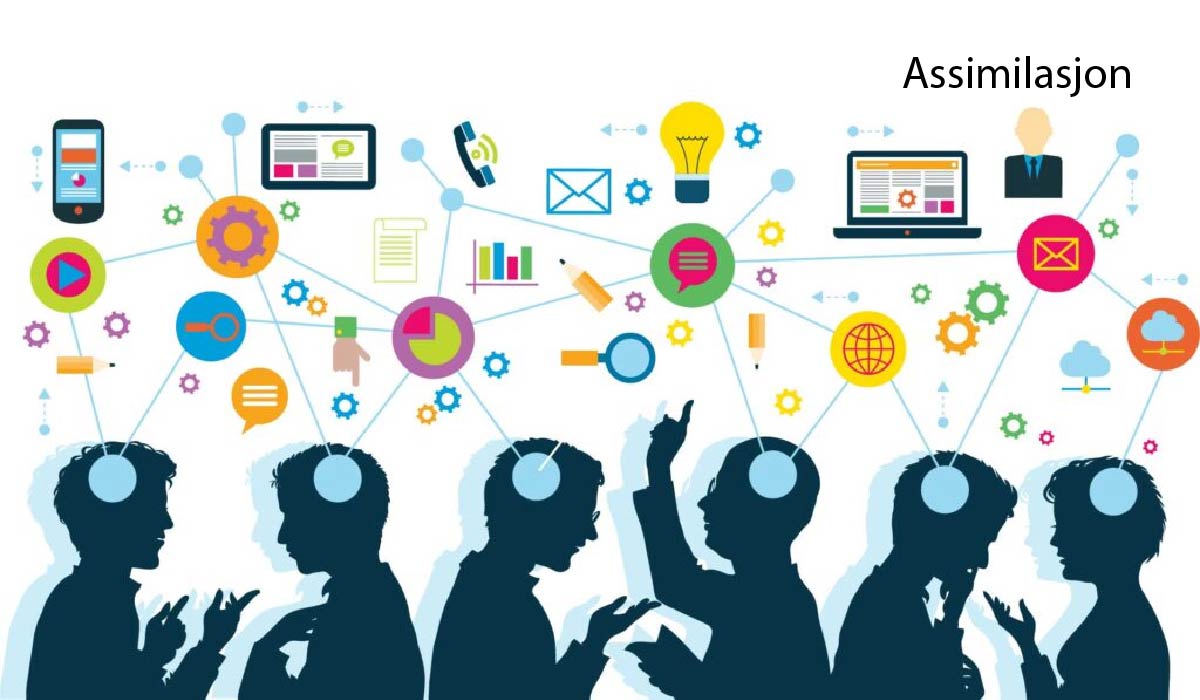Assimilasjon is the process by which individuals or groups from one culture gradually adopt the language, values, norms, and behaviors of another, typically dominant, culture. In simple terms, it means blending in with a new social environment by adjusting one’s identity and lifestyle to fit the prevailing culture. This process plays a vital role in migration, cultural transitions, and identity formation.
As globalization accelerates human movement across borders, the concept of assimilasjon becomes increasingly relevant. Whether through international migration, refugee resettlement, or economic relocation, the need to adapt to new cultural surroundings brings assimilasjon into focus. This article explores the full scope of assimilasjon: its history, underlying theory, forms, psychological effects, and policy implications, while also examining real-world examples and the future trajectory of cultural assimilation in an interconnected world.
The History of Assimilasjon – From Ancient Empires to Modern Nations
The origins of assimilasjon can be traced back to ancient empires such as the Roman Empire, which implemented policies encouraging conquered peoples to adopt Roman customs, language, and legal systems. Assimilation was used as a tool of governance, helping unify vast and diverse populations under a single imperial culture. Fast-forward to the 19th and 20th centuries, and the concept became central in the national identity-building efforts of modern states like the United States, France, and Scandinavian countries.
In these regions, immigrants were often expected to conform to the dominant culture quickly by learning the national language and adopting local customs. However, this process was not always voluntary. Indigenous groups such as the Sami in Norway faced systemic forced assimilation, including language bans and cultural erasure. Over time, societal attitudes have evolved, acknowledging the harm caused by coercive assimilation and moving toward more inclusive models of cultural coexistence.
What Is Assimilasjon? – A Deeper Conceptual Understanding
Assimilasjon in sociological terms involves a process of cultural absorption where minority individuals gradually adopt the characteristics of a dominant culture. It is distinct from acculturation, which refers to the exchange and adoption of cultural traits between groups while maintaining distinct identities. Assimilasjon implies a one-directional shift and often involves the reduction or loss of the original cultural identity. The process may be driven by the host society through laws, education, and media, or by the minority groups themselves as they seek social acceptance, economic advancement, or safety. Power dynamics play a crucial role in this transformation, as the dominant culture often dictates the terms of assimilation, leading to potential inequality in cultural negotiation and identity formation.
The Different Types of Assimilasjon
Assimilasjon can be broken down into several types. Cultural assimilation involves adopting the dominant group’s language, fashion, food habits, and celebrations. This is often the most visible form of assimilation and usually occurs over generations. Structural assimilation goes deeper, encompassing integration into institutions such as schools, workplaces, and governmental systems, ensuring equal access and participation.
Identificational assimilation refers to an emotional and cognitive alignment with the dominant culture, where individuals start to see themselves primarily as members of the host society. Civic assimilation involves accepting and participating in the political and legal framework of the country. Economic assimilation ensures immigrants become active contributors to the labor market. All these forms can be either voluntary, driven by personal ambition and opportunity, or forced, where policies demand abandonment of the original identity.
Assimilasjon in Multicultural and Modern Societies
Modern multicultural societies offer a complex backdrop for assimilasjon. Countries like Canada officially promote multiculturalism, encouraging individuals to maintain their heritage while contributing to national unity. In contrast, countries like France enforce a more rigid model of national identity and secularism, expecting immigrants to fully assimilate into the French way of life.
The United States presents a mixed model, often described as a “melting pot” where diverse cultures blend yet retain distinct community traits. Norway’s experience with the Sami people demonstrates the tension between cultural preservation and enforced assimilation. Education systems, government policies, and media play influential roles in shaping assimilation pathways. Global migration and digital connectivity further complicate the picture, allowing people to stay connected to their homeland culture while adapting to a new society.
Psychological Impact of Assimilasjon on Individuals
The process of assimilasjon is deeply psychological. For many individuals, particularly second-generation immigrants, assimilation can lead to identity conflicts. They may feel torn between the cultural expectations of their family and the society they are trying to fit into. This phenomenon, often called “dual identity” or “bicultural stress,” can result in emotional confusion, guilt, or a sense of alienation. On the positive side, assimilation can boost self-esteem by providing a sense of belonging, social inclusion, and opportunity. Coping mechanisms vary: some adopt a bicultural identity that harmonizes elements of both cultures, while others code-switch depending on their social environment. Mental health professionals and community support groups can play an important role in helping individuals navigate this complex psychological journey.
Language and Communication – The First Step in Assimilasjon
Language acquisition is often the first and most critical step in assimilasjon. Learning the dominant language opens doors to education, employment, and social interaction. It also facilitates understanding of societal values, humor, media, and politics. For immigrants, language mastery is both a tool for survival and a pathway to integration. However, the shift from one’s native language to a new one can also create generational divides within families. Children may become fluent more quickly and adopt new cultural norms, sometimes leading to a reversal of roles where children help their parents navigate society. Educational programs such as ESL (English as a Second Language) courses and bilingual education support this transition and are essential for successful linguistic assimilation.
Assimilasjon vs. Integration – What’s the Difference?
While often used interchangeably, assimilasjon and integration are distinct concepts. Assimilation implies that immigrants conform to the dominant culture, often at the expense of their own. It’s a one-way process where the minority is expected to change. Integration, on the other hand, is a two-way exchange where both the host society and newcomers adapt to each other, promoting mutual respect and cultural diversity. Multiculturalism is closely aligned with integration, encouraging coexistence without cultural erasure. Policies that favor integration often result in healthier societies where people feel included without feeling forced to abandon their heritage. The success of either approach depends heavily on policy implementation, societal attitudes, and support systems in place.
Government Policies and the Politics of Assimilasjon
Governments play a central role in shaping assimilasjon. Some implement policies that promote linguistic and cultural assimilation through education and public messaging. For example, mandatory language proficiency tests for citizenship or bans on cultural dress in public institutions can reflect an assimilationist stance. Critics argue that such policies can alienate minority groups and undermine social cohesion. Progressive alternatives involve inclusive policies that support both assimilation and heritage preservation. Anti-discrimination laws, funding for cultural programs, and inclusive curricula in schools can help balance unity with diversity. Political discourse surrounding assimilation also influences public perception, often framing it either as a necessity for national unity or as a threat to cultural identity.
Technology and Assimilasjon in the Digital Era
In today’s digital age, technology adds a new dimension to assimilasjon. Social media platforms enable immigrants to maintain close ties with their native culture while simultaneously engaging with the culture of their new environment. Online communities, diaspora networks, and digital news sources allow for cultural continuity across borders. On the other hand, the internet also accelerates exposure to dominant cultural trends, making assimilation more accessible through media, entertainment, and virtual education. Digital tools such as translation apps, language-learning platforms, and remote work further support assimilation by removing traditional barriers. This duality creates hybrid cultural identities that reflect a blend of global influences and localized experiences.
Advantages of Assimilasjon – Individual and Societal Benefits
Assimilasjon offers numerous benefits. For individuals, it provides increased access to social mobility, job markets, and educational opportunities. It facilitates a stronger sense of belonging and participation in the community. For societies, assimilation can lead to greater social cohesion, reduced cultural friction, and a more unified national identity. Economically, assimilated populations contribute more actively to the workforce and tax base, enhancing national productivity. Socially, shared language and values can reduce misunderstandings and promote civic harmony. When done voluntarily and respectfully, assimilation becomes a powerful force for unity and growth.
Disadvantages and Criticisms of Assimilasjon
Despite its benefits, assimilasjon is not without its drawbacks. One major criticism is that it often leads to cultural loss. Minority languages, traditions, and identities may be eroded in the effort to conform. The pressure to assimilate can result in self-rejection, especially when individuals feel forced to abandon their roots. Discrimination and exclusion can still persist despite full assimilation, revealing the limitations of cultural conformity. Critics also argue that assimilation privileges the dominant culture, reinforcing existing power imbalances and marginalizing alternative voices. Balancing assimilation with cultural preservation remains a key challenge in pluralistic societies.
Global Examples of Assimilasjon in Action
Around the world, assimilasjon takes on different forms. In the United States, assimilation has historically been promoted through the concept of the “melting pot,” where immigrants blend into a single national identity. Yet, many communities have resisted full assimilation, maintaining cultural enclaves and bilingualism. In Norway, the forced assimilation of the Sami people led to loss of language and identity, a legacy now being redressed through cultural revitalization. France exemplifies strict secular assimilation, banning religious symbols in public spaces to enforce a unified cultural norm. Canada’s approach contrasts sharply with policies promoting integration and multiculturalism. In countries like South Korea and Japan, cultural homogeneity creates significant pressure for immigrants to conform, often at the expense of their original identity.
Supporting Assimilasjon – What Can Societies Do Right?
To support healthy assimilasjon, societies must provide both opportunity and protection. Language programs, adult education, and inclusive school curricula are foundational. Legal frameworks must protect against discrimination and promote equality. Community centers and cultural festivals can create spaces for expression and mutual learning. Policymakers should avoid coercive tactics and instead foster environments where assimilation is a choice supported by resources. Encouraging dialogue between cultures through art, education, and public discourse can ease transitions and strengthen social bonds. The goal should not be to erase diversity, but to build a society where different backgrounds enrich the common identity.
The Future of Assimilasjon – What Lies Ahead?
Looking ahead, assimilasjon is likely to become more fluid and dynamic. Younger generations, especially Gen Z, often embody hybrid identities that defy traditional categories. As globalization continues, cultural borders will become increasingly porous. AI and translation technologies may reduce the need for linguistic assimilation, while also creating new forms of cultural connection. Transculturalism—the idea of living across and beyond cultures—is emerging as a more accurate model of modern identity. Governments and communities must adapt to these shifts by rethinking assimilation not as an endpoint but as a flexible, ongoing process of mutual adaptation and understanding.
Conclusion
Assimilasjon is not a simple or uniform process. It encompasses cultural, psychological, political, and economic dimensions that shape both individuals and societies. While it can offer belonging, opportunity, and unity, it also poses risks to cultural diversity and personal identity. The challenge lies in finding a balance where people can adapt to new environments without losing their roots. Understanding and respecting the multifaceted nature of assimilasjon is key to building inclusive societies that honor both change and continuity. As the world becomes more interconnected, the ability to navigate this journey thoughtfully will define the success of our shared future.
FAQs About Assimilasjon
FAQ 1: What does assimilasjon mean in simple words?
Assimilasjon means when people from one culture slowly adopt the language, traditions, and way of life of another culture, often the one that is more common or dominant in a society.
FAQ 2: What is an example of assimilasjon?
An example of assimilasjon is when immigrants move to a new country and start speaking the local language, wearing local clothes, and celebrating the country’s holidays to fit in with the society.
FAQ 3: What is the difference between assimilasjon and integration?
Assimilasjon means changing to become like the main culture, often by giving up your original culture. Integration means keeping your own culture while also becoming part of the new society.
FAQ 4: Why is assimilasjon important?
Assimilasjon helps people adjust to a new culture, find jobs, make friends, and feel like they belong. It can create unity in a society and help different groups live together peacefully.
FAQ 5: What are the problems with assimilasjon?
The problems with assimilasjon include losing your original culture, language, or traditions. Some people may feel pressure to change too much, which can lead to stress or identity confusion.
For More Information, Visit Megamagazine















